My time in Ecuador – A travel report – part 1 (EN/ES) | Mi tiempo en Ecuador - Un informe de viaje - parte 1 (EN/ES)
Spanish below, thanks to deepl translator | Español abajo, gracias al traductor deepl
In 2004 I spent 2 months in Ecuador and did an internship at the Fundación Ecológica Curiquingue, which is now apparently called Estacion Reserva Forestal Apayacu. The Fundación is located about halfway from Tena, province Napo, to Tena-Jumandy airport on the (not yet asphalted at the time) road E436 south of the beautiful Rio Napo.
The aim of our work was to protect and preserve the rainforest, and I think this work is just as relevant today as it was 21 years ago.
My photographic equipment back then was not so good. I had a simple digital camera and 2 or 3 256MB SD cards, the contents of which got burnt to CD every week in the internet café in Tena to make space for new pictures. I'm not going to edit the pictures either, they show the charm of those days.
Welcome to my little journey through the Oriente and the subsequent 3-week round trip through this wonderful country.
From Germany to the Y de Misahualli
Getting to the destination is not exactly easy or cheap. One of the reasons why I haven't had the opportunity to visit Ecuador since.
After 14 hours in 3 aeroplanes with stopovers in Frankfurt, Caracas and Bogota, I finally landed in Quito late in the evening. As a lowlander, I was immediately out of breath and it took me a while to cope with the lack of oxygen at this altitude. The backpack felt twice as heavy.
In the morning, after a short night in a cheap hotel, I made my way to the bus station. My Spanish was very poor and still isn't much better today. So I bought the first available ticket to Tena without knowing what I was doing. And of course for the wrong bus company. However, I only realised this when I was checked during the journey and bought another valid ticket for this company.
This 6-hour journey from Quito to Tena made a big impression on me. The rapid change of scenery from the mountains down to the rainforest, the many new impressions, a completely new world for me. All this without any knowledge of Spanish or a map. No mobile phone, no Google Maps, just a rough plan in my head.
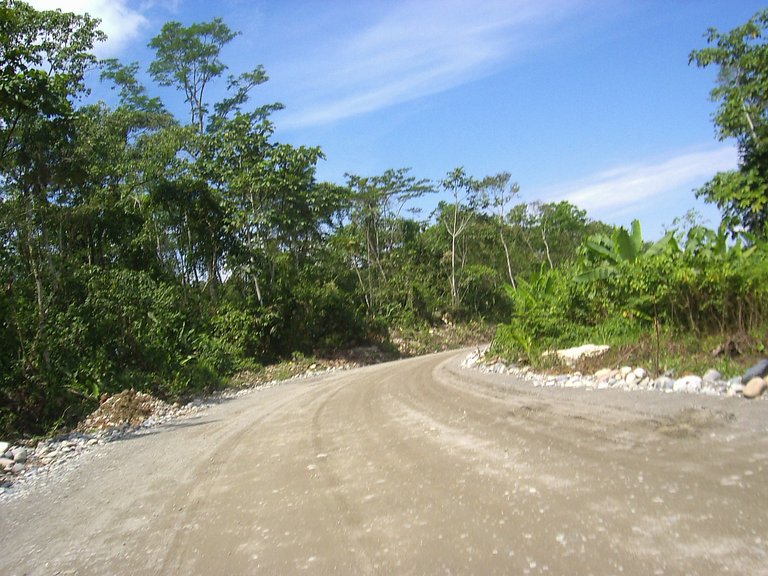
Once we arrived in Tena, we took the next bus to our destination, this time with a valid ticket. I somehow managed to tell bus driver understand where I wanted to get off and he stopped in the middle of the road to let me know that we were at our destination, Y de Misahualli. Hooray!
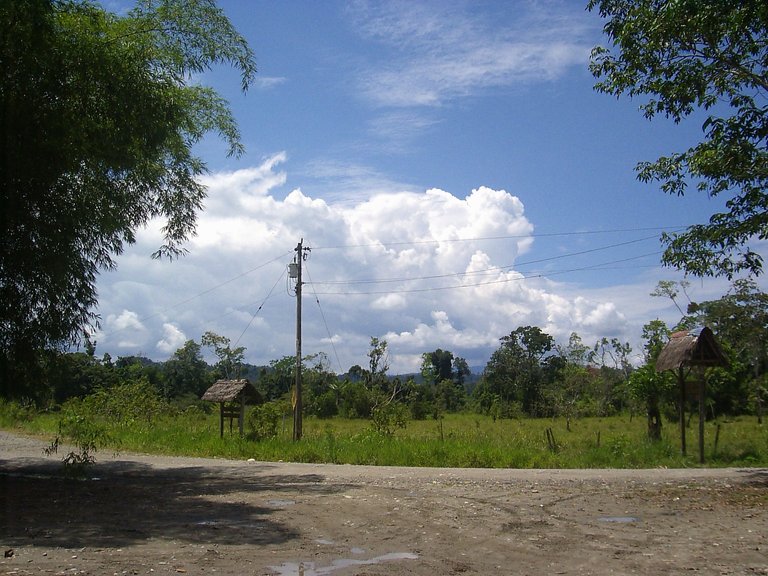
Now it's just a few minutes' walk through the forest and I've reached the Fundación.

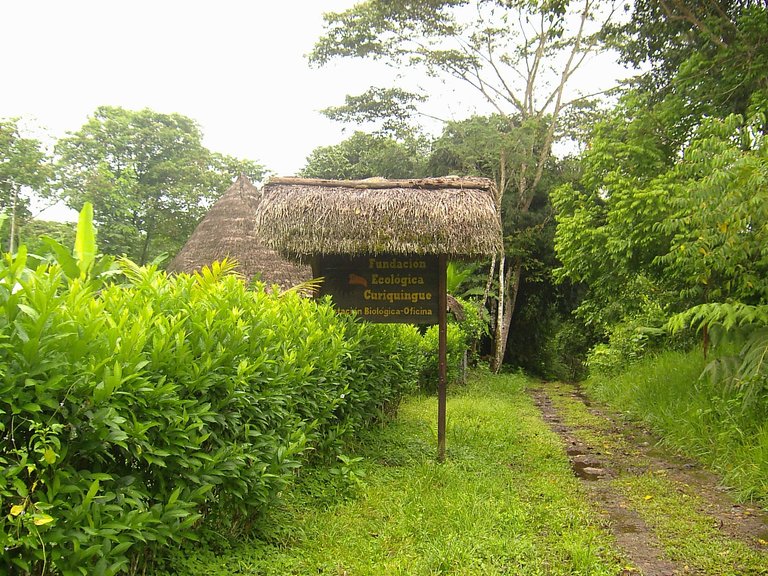
First steps in the new surroundings
It wasn't easy for me to find my way around at first due to my lack of language skills. Fortunately, I already had friends on site who were also doing an internship and were able to help me translate.
Over the next few days, I settled into my hut, realised that leather shoes were pointless in the rainforest and bought myself a good pair of wellies. Equipped to a certain extent, I began to explore the forest around our camp and couldn't stop being amazed. I admit that I had problems with the damp climate in the first few days, but you get used to it quite quickly.
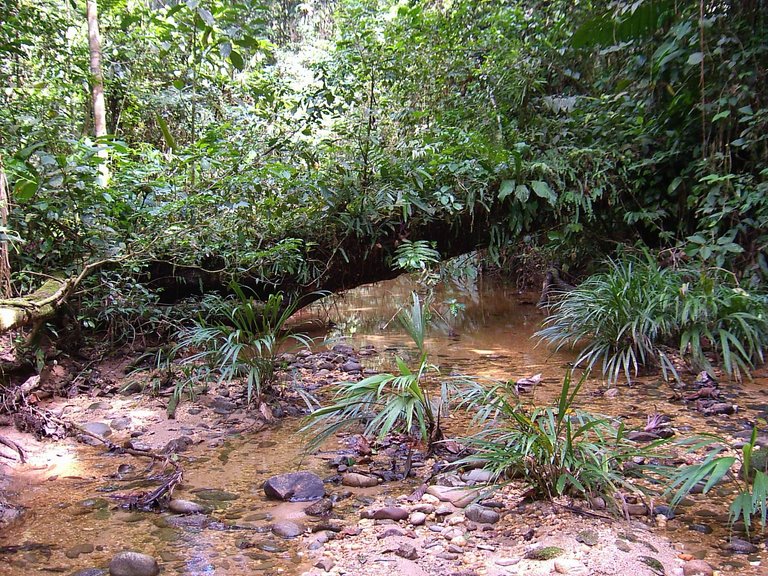

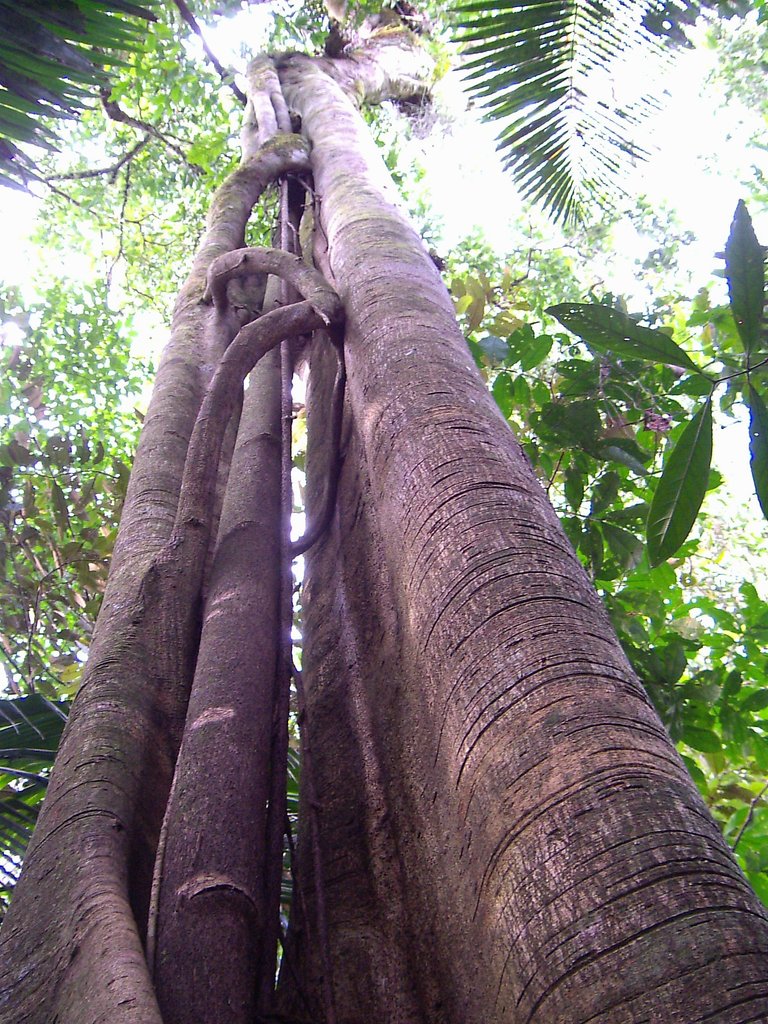
My first steps in the secondary forest, an impressive experience.
A major challenge, but what an outlook
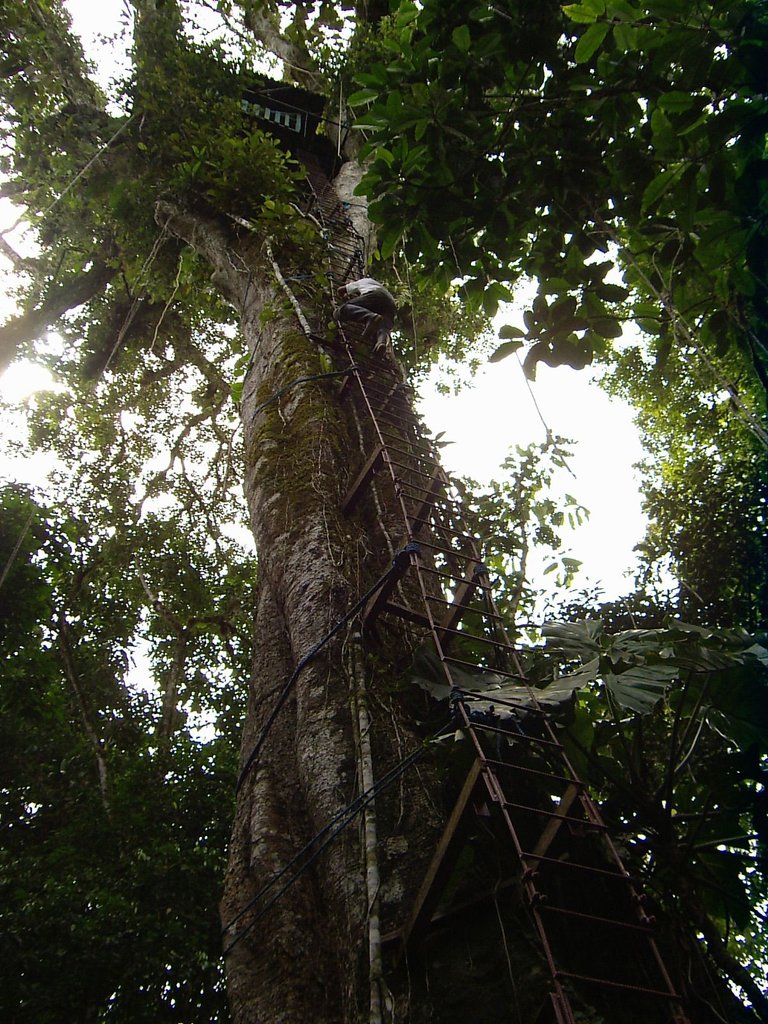
I have problems with great heights. But that's exactly what this trip to the Torre, a tree house over 30 metres high that can only be reached via a thin metal ladder, was all about. After some hesitation, I got over myself and climbed up. And what can I say? The view was overwhelming. You could even see the Rio Napo.
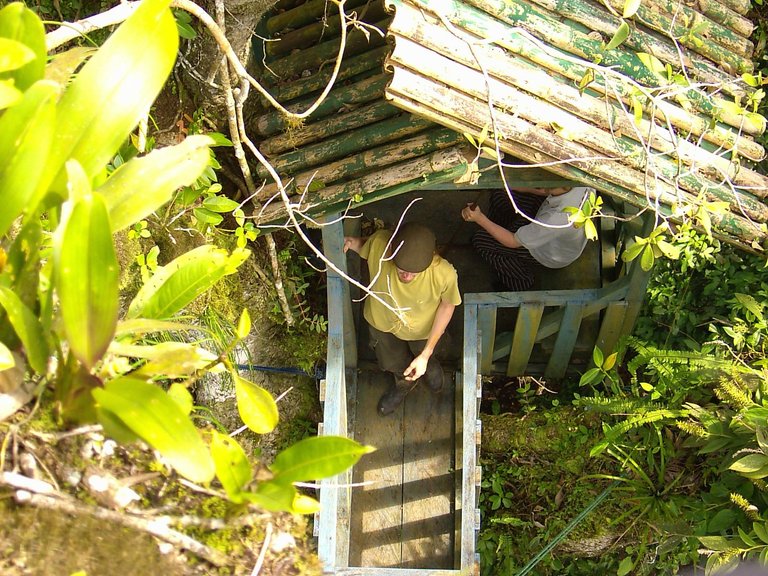 | 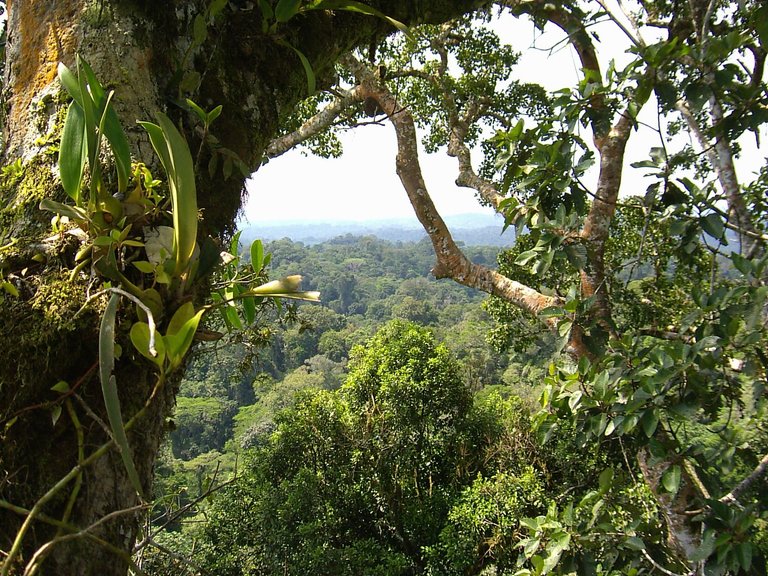 | 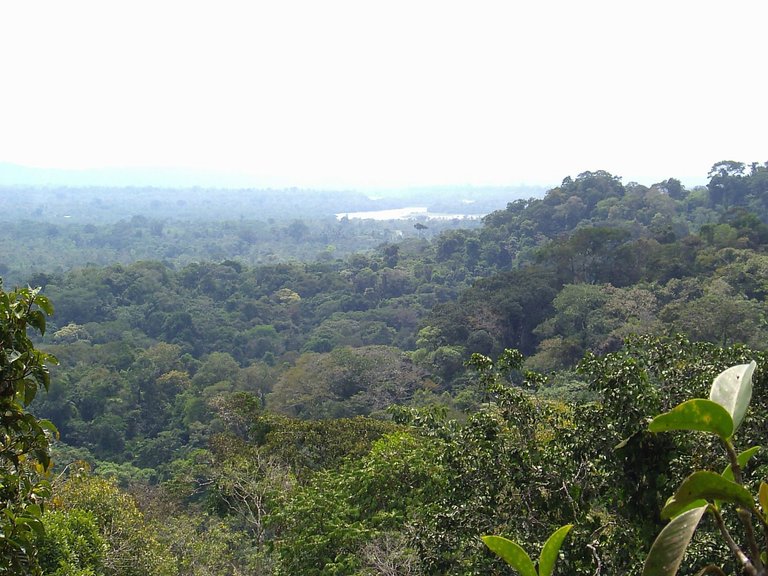 |
|---|
That's it for the first part of my little travel report. Enough adventure for today. I hope you enjoyed it and I'll see you again in the next part.
Mi tiempo en Ecuador - Un informe de viaje - parte 1
En 2004 pasé 2 meses en Ecuador y realicé unas prácticas en la Fundación Ecológica Curiquingue, que al parecer ahora se llama Estación Reserva Forestal Apayacu. La Fundación se encuentra a mitad de camino entre Tena, provincia de Napo, y el aeropuerto de Tena-Jumandy, en la carretera E436 (que entonces aún no estaba asfaltada), al sur del hermoso río Napo.
El objetivo de nuestro trabajo era proteger y preservar la selva tropical, y creo que este trabajo es tan relevante hoy como lo era hace 21 años.
Mi equipo fotográfico de entonces no era muy bueno. Tenía una cámara digital sencilla y 2 o 3 tarjetas SD de 256 MB, cuyo contenido se grababa en CD cada semana en el cibercafé de Tena para dejar espacio a nuevas fotos. Tampoco voy a editar las fotos, muestran el encanto de aquellos días.
Bienvenidos a mi pequeño viaje por Oriente y la posterior vuelta de 3 semanas por este maravilloso país.
De Alemania a la Y de Misahualli
Llegar al destino no es precisamente fácil ni barato. Una de las razones por las que no he vuelto a tener la oportunidad de visitar Ecuador.
Tras 14 horas en 3 aviones con escalas en Fráncfort, Caracas y Bogotá, por fin aterricé en Quito a última hora de la tarde. Como habitante de las tierras bajas, me quedé sin aliento enseguida y tardé un rato en asimilar la falta de oxígeno a esta altitud. La mochila pesaba el doble.
Por la mañana, tras una corta noche en un hotel barato, me dirigí a la estación de autobuses. Mi español era muy malo y todavía no ha mejorado mucho. Así que compré el primer billete disponible a Tena sin saber lo que hacía. Y, por supuesto, me equivoqué de compañía. Sin embargo, sólo me di cuenta cuando me controlaron durante el viaje y compré otro billete válido para esta compañía.
Este viaje de 6 horas de Quito a Tena me impresionó mucho. El rápido cambio de paisaje de las montañas a la selva tropical, las muchas impresiones nuevas, un mundo completamente nuevo para mí. Todo ello sin saber español ni mapa. Ni teléfono móvil, ni Google Maps, sólo un plan aproximado en mi cabeza.

Una vez que llegamos a Tena, tomamos el siguiente autobús a nuestro destino, esta vez con un billete válido. De alguna manera me las arreglé para decirle al conductor del autobús que entendiera dónde quería bajarme y se paró en medio de la carretera para comunicarme que estábamos en nuestro destino, Y de Misahualli. ¡Hurra!

Ahora sólo me quedan unos minutos de caminata por el bosque y he llegado a la Fundación.


Primeros pasos en el nuevo entorno
Al principio no me resultó fácil orientarme debido a mi falta de conocimientos lingüísticos. Por suerte, tenía amigos que también estaban haciendo prácticas y me ayudaron a traducir.
En los días siguientes me instalé en mi cabaña, me di cuenta de que los zapatos de cuero eran inútiles en la selva y me compré un buen par de botas de agua. Equipado hasta cierto punto, empecé a explorar el bosque que rodeaba nuestro campamento y no dejaba de sorprenderme. Reconozco que los primeros días tuve problemas con el clima húmedo, pero uno se acostumbra enseguida.



Mis primeros pasos en el bosque secundario, una experiencia impresionante.
Un gran reto, pero qué perspectiva

Tengo problemas con las grandes alturas. Pero de eso se trataba exactamente esta excursión a la Torre, una casa en un árbol de más de 30 metros de altura a la que sólo se puede acceder por una fina escalera metálica. Tras algunas dudas, me sobrepuse y subí. ¿Y qué puedo decir? La vista era abrumadora. Incluso se podía ver el río Napo.
 |  |  |
|---|
Hasta aquí la primera parte de mi pequeño informe de viaje. Suficiente aventura por hoy. Espero que os haya gustado y nos vemos en la próxima parte.
All photos are taken with a random old digital camera by me,
@cryptozeug, unless otherwise stated. Polished with Affinity Photo.

Thank you for your visit!

Congratulations @cryptozeug! You have completed the following achievement on the Hive blockchain And have been rewarded with New badge(s)
Your next target is to reach 200 comments.
Your next target is to reach 700 upvotes.
You can view your badges on your board and compare yourself to others in the Ranking
If you no longer want to receive notifications, reply to this comment with the word
STOPOk, part 2 when? That treehouse has some amazing views!
Do you know what kind of trees those are the grew together?
Oh yeah, the photos still look great!
!PIZZA
When I remember right, it's a Strangler Fig Tree (Ficus area / Matapalo). It initially lives as an epiphyte on the host tree, then sends down roots and strangles the host. So what you see are roots.
Next part when I found the time. This one took the whole day.
Great! looking forward to it. I had no idea it was a parasitic plant.
$PIZZA slices delivered:
@txracer(1/15) tipped @cryptozeug
Come get MOONed!
DANG, I love a walk down memory lane even if they aren't my memories. These pics are cool
Thank you. Yes, I felt like being back in that days when writing the post. Pretty relaxing.
this is so freaking cool dude... even I have not been to the Amazon area... I should be embarrassed.
What, really? And I thought I show things that are normal and already seen by most people. Ok, there are some more highlights to come, I just need to find the time to compose them.
Excelentes fotos para un espacio cargado de verde y vida!!! :P
¡Muchas gracias!
@cryptozeug, I paid out 0.178 HIVE and 0.000 HBD to reward 5 comments in this discussion thread.